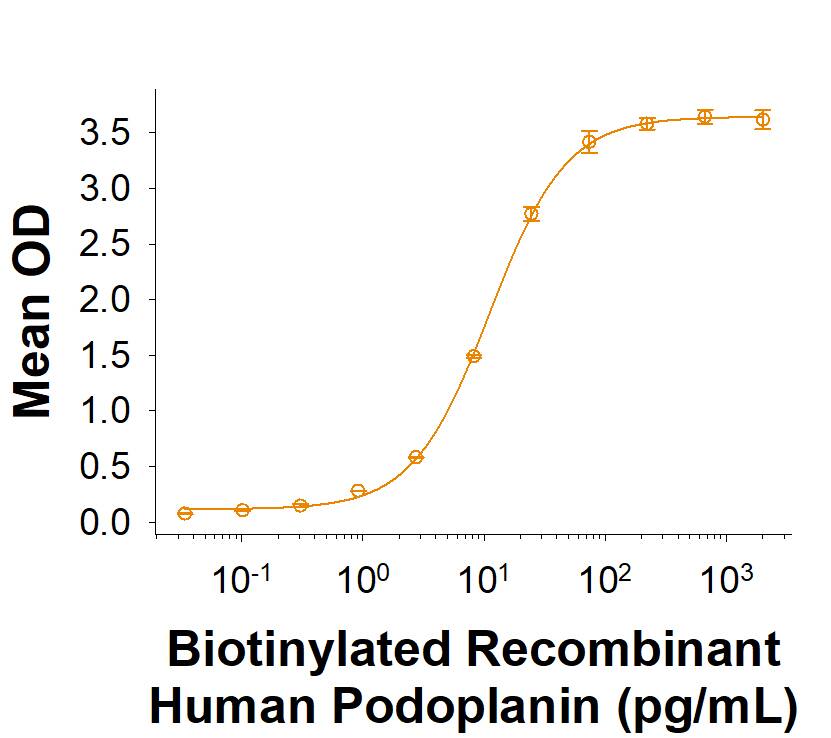Recombinant Human CLEC-2/CLEC1B Fc Chimera Protein, CF
R&D Systems, part of Bio-Techne | Catalog # 11211-CL

Key Product Details
Source
CHO
Accession #
Structure / Form
Disulfide-linked homodimer
Conjugate
Unconjugated
Applications
Bioactivity
Product Specifications
Source
Chinese Hamster Ovary cell line, CHO-derived human CLEC-2/CLEC1B protein
| MD | Human IgG1 (Pro100-Lys330) |
IEGR | Human CLEC1B (Gln58-Pro229) Accession # Q9P126.2 |
| N-terminus | C-terminus | ||
Purity
>90%, by SDS-PAGE visualized with Silver Staining and quantitative densitometry by Coomassie® Blue Staining.
Endotoxin Level
<0.10 EU per 1 μg of the protein by the LAL method.
N-terminal Sequence Analysis
Met1 of Fc Chimera
Predicted Molecular Mass
47 kDa
SDS-PAGE
56-65 kDa, under reducing conditions.
Activity
Measured by its binding ability in a functional ELISA.
When Recombinant Human CLEC-2/CLEC1B Fc Chimera (Catalog # 11211-CL) is immobilized at 1 µg/mL (100 µL/well), Biotinylated Recombinant Human Podoplanin Fc Chimera binds with an ED50 of 6.00-60.0 pg/mL.
When Recombinant Human CLEC-2/CLEC1B Fc Chimera (Catalog # 11211-CL) is immobilized at 1 µg/mL (100 µL/well), Biotinylated Recombinant Human Podoplanin Fc Chimera binds with an ED50 of 6.00-60.0 pg/mL.
Scientific Data Images for Recombinant Human CLEC-2/CLEC1B Fc Chimera Protein, CF
Recombinant Human CLEC-2/CLEC1B Fc Chimera Protein Binding Activity.
When Recombinant Human CLEC-2/CLEC1B Fc Chimera (Catalog # 11211-CL) is immobilized at 1 µg/mL (100 µL/well), Biotinylated Recombinant Human Podoplanin Fc Chimera binds with an ED50 of 6.00-60.0 pg/mL.Recombinant Human CLEC-2/CLEC1B Fc Chimera Protein SDS-PAGE.
2 μg/lane of Recombinant Human CLEC-2/CLEC1B Fc Chimera Protein (Catalog # 11211-CL) was resolved with SDS-PAGE under reducing (R) and non-reducing (NR) conditions and visualized by Coomassie® Blue staining, showing bands at 56-65 kDa and 110-130 kDa, respectively.Formulation, Preparation and Storage
11211-CL
| Formulation | Lyophilized from a 0.2 μm filtered solution in PBS with Trehalose. |
| Reconstitution | Reconstitute at 500 μg/mL in PBS. |
| Shipping | The product is shipped at ambient temperature. Upon receipt, store it immediately at the temperature recommended below. |
| Stability & Storage | Use a manual defrost freezer and avoid repeated freeze-thaw cycles.
|
Background: CLEC-2/CLEC1B
References
- Colonna, M. et al. (2000) Eur. J. Immunol. 30:697.
- Christou, C.M. et al. (2008) Biochem. J. 411:133.
- Watson, A.A. et al. (2007) J. Biol. Chem. 282:3165.
- Suzuki-Inoue, K. et al. (2006) Blood 107:542.
- Fuller, G.L. et al. (2007) J. Biol. Chem. 282:12397.
- Weis, W.I. et al. (1998) Immunol. Rev. 163:19.
- Suzuki-Inoue, K. et al. (2007) J. Biol. Chem. 282:25993.
- Chaipan, C. et al. (2006) J. Virol. 80:8951.
Long Name
C-type Lectin-like Receptor 2
Alternate Names
CLEC1B, CLEC2
Gene Symbol
CLEC1B
UniProt
Additional CLEC-2/CLEC1B Products
Product Documents for Recombinant Human CLEC-2/CLEC1B Fc Chimera Protein, CF
Product Specific Notices for Recombinant Human CLEC-2/CLEC1B Fc Chimera Protein, CF
For research use only
